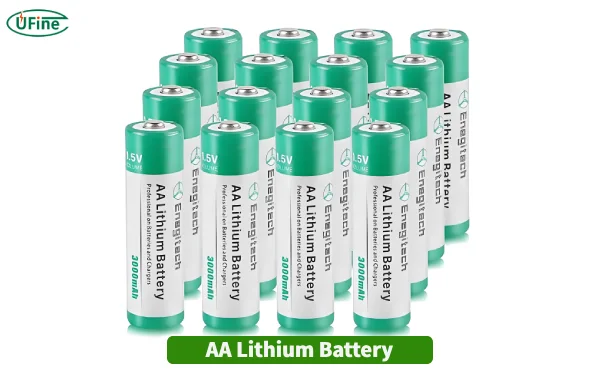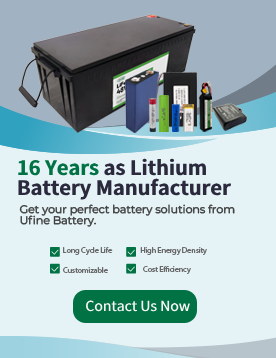
- Part 1. What is a lithium metal AA battery?
- Part 2. Can lithium metal batteries be recharged?
- Part 3. Lithium metal AA battery parameters
- Part 4. Lithium metal AA vs lithium-ion AA batteries
- Part 5. AA lithium vs lithium-Ion vs alkaline vs NiMH
- Part 6. Applications of lithium metal AA Batteries
- Part 7. Lifespan and storage
- Part 9. Advantages and limitations
- Part 8. AA battery buying guide
- Part 10. FAQs
Are AA batteries lithium? If you’re looking for long-lasting, high-performance batteries for your devices, understanding the difference between lithium metal AA batteries and lithium-ion AA batteries is crucial. In this guide, we’ll break down the characteristics, applications, and advantages of each, helping you choose the best battery for your needs.
Part 1. What is a lithium metal AA battery?
Lithium metal AA batteries are a type of primary cell battery, meaning they are designed for single-use and cannot be recharged. They are widely known for their high energy density due to the use of lithium metal as the anode. This allows them to store more energy than conventional alkaline batteries, providing longer runtime for devices such as smoke detectors, digital cameras, and remote controls.
Key features of lithium metal AA batteries include:
- Voltage Stability: Maintains a steady 1.5V output throughout the discharge cycle, ensuring reliable performance.
- Shelf Life: Can retain charge for up to 10 years under proper storage conditions, making them ideal for emergency and backup applications.
- High Performance in Extreme Temperatures: Unlike alkaline batteries, lithium metal AA batteries perform well in very cold or hot environments.
While highly reliable, these batteries are non-rechargeable, so they must be replaced after use.
Part 2. Can lithium metal batteries be recharged?
No, lithium metal AA batteries cannot be recharged. Attempting to recharge them can be dangerous, as it may cause leakage, overheating, or even fire. Only lithium-ion batteries and other rechargeable chemistries, like NiMH, are designed for repeated charging and discharging.
Note: If your device requires a rechargeable solution, companies like Ufine Battery provide custom lithium-ion AA and cylindrical batteries that can be safely recharged hundreds of times while maintaining performance and longevity.
Part 3. Lithium metal AA battery parameters
Lithium metal AA batteries adhere to standard AA dimensions (14mm × 50mm), ensuring compatibility with most devices. Their typical capacity is around 3000 mAh, which is significantly higher than most alkaline batteries.
Other considerations include:
- Environmental Impact: Single-use batteries create more waste, so proper recycling is important.
- Device Compatibility: Works with a wide range of low-drain devices, but not suitable for devices requiring rechargeable cells.
Part 4. Lithium metal AA vs lithium-ion AA batteries
| Feature | Lithium Metal AA | Lithium-Ion AA |
|---|---|---|
| Chemistry | Lithium metal anode, non-rechargeable | Lithium-ion compound, rechargeable |
| Voltage | 1.5V | 3.6–3.7V per cell |
| Size | Standard AA | Varies (e.g., 18650, cylindrical) |
| Rechargeable | No | Yes |
| Lifespan | Up to 10 years in storage | 300–500 cycles or more |
| Cost | Lower upfront, higher over time | Higher upfront, economical long-term |
| Safety | Generally safer, no thermal runaway | Risk of overheating if mishandled |
| Environmental | Single-use, more waste | Rechargeable, reduces waste if recycled |
Key Differences Explained:
- Rechargeability and Cycle Life: Lithium-ion batteries are designed for repeated charging and discharging, making them ideal for high-drain devices like smartphones, cameras, and portable electronics. Lithium metal AA batteries, however, are best suited for devices that require long shelf life and low-drain usage.
- Applications: Lithium metal AA batteries excel in smoke detectors, medical devices, flashlights, and other emergency equipment. Lithium-ion AA cells are ideal for rechargeable devices where frequent replacement would be inconvenient.
Part 5. AA lithium vs lithium-Ion vs alkaline vs NiMH
| Battery Type | Chemistry | Voltage | Rechargeable | Typical Capacity | Best Use Cases |
|---|---|---|---|---|---|
| Lithium Metal AA | Lithium metal | 1.5V | No | ~3000 mAh | Smoke detectors, emergency kits, low-drain devices |
| Lithium-Ion AA | Lithium-ion | 3.6–3.7V | Yes | 2000–3000 mAh | High-drain devices, cameras, portable electronics |
| Alkaline AA | Zinc/Manganese | 1.5V | No | 2000–2500 mAh | Low-to-moderate drain devices, general household use |
| NiMH AA | Nickel-metal hydride | 1.2V | Yes | 1800–2500 mAh | Rechargeable devices, toys, high-drain electronics |
This table helps you quickly compare performance, rechargeability, and device suitability, so you can make an informed choice.
Part 6. Applications of lithium metal AA Batteries
Lithium metal AA batteries are suitable for a variety of low-drain and critical devices:
- Smoke Detectors: Reliable power for several years with minimal maintenance.
- Digital Cameras: Stable voltage allows longer shooting sessions, especially for high-performance cameras.
- Flashlights: Outdoor and professional users benefit from consistent brightness and extended runtime.
- Medical Devices: Critical equipment benefits from long shelf life and dependable power.
Their stability in extreme temperatures and extended shelf life makes them an excellent choice for emergency kits, safety devices, and outdoor equipment.
For users seeking rechargeable, high-performance lithium solutions, Ufine Battery provides customizable lithium-ion batteries suitable for consumer electronics, industrial devices, and specialized high-drain applications.
Part 7. Lifespan and storage
The lifespan of a lithium metal AA battery depends on storage and usage:
- Storage Conditions: Keep in a cool, dry place to maximize shelf life. Under optimal conditions, these batteries can retain charge for up to 10 years.
- Usage Scenarios: Low-drain devices like smoke detectors can run on a single battery for years, while high-drain devices like digital cameras may use them more quickly.
Part 9. Advantages and limitations
Advantages:
- Long shelf life and stable voltage
- Lightweight and high energy density
- Excellent performance in extreme temperatures
Limitations:
- Non-rechargeable (for lithium metal)
- Higher cost over time compared to rechargeable lithium-ion solutions
- Requires careful disposal to reduce environmental impact
Part 8. AA battery buying guide
When buying AA batteries, consider these factors:
- Device Requirements: Check if your device needs rechargeable cells or single-use batteries.
- Voltage and Chemistry: Match voltage requirements (1.5V for AA lithium metal, 3.6V for Li-ion AA).
- Energy Demands: High-drain devices benefit from lithium or NiMH batteries; low-drain devices work well with alkaline or lithium metal.
- Temperature and Storage: Choose batteries suited for cold or hot environments.
- Brand Reliability: Trusted brands ensure consistent performance. For custom rechargeable solutions, Ufine Battery offers high-quality lithium-ion AA and cylindrical batteries with tailored voltage, capacity, and discharge rates to meet your project needs.
Part 10. FAQs
Are AA batteries lithium?
Some AA batteries are lithium metal (single-use) or lithium-ion (rechargeable). Always check the label and device requirements.
Can lithium metal AA batteries replace alkaline batteries?
Yes, in most devices that accept AA size, but non-rechargeable lithium should not be used where rechargeability is required.
How long do lithium metal AA batteries last?
Up to 10 years in storage and several years in low-drain devices like smoke detectors.
Are lithium metal AA batteries suitable for cold environments?
Yes, they perform reliably in extreme temperatures, unlike alkaline batteries that lose efficiency in cold conditions.
Can I get custom lithium batteries for my devices?
Yes. Ufine Battery offers custom rechargeable lithium-ion batteries with tailored sizes, voltages, capacities, and discharge rates for various applications.
Can lithium metal batteries be recharged?
No. Only lithium-ion or other rechargeable chemistries can be safely recharged.
Related Tags:
More Articles

1.5V Battery Vs. 1.2V Battery: Comparison of Their Differences
Compare 1.2V vs 1.5V batteries: voltage, usage, rechargeability. Best for remotes, toys, cameras. Discover which AA battery suits your device.
Recommended 10 Best Batteries For Smoke Detectors
Discover the best batteries for smoke detectors in 2025. Compare top 10 9V and AA options for long-lasting, leak-proof, and reliable smoke alarm power.
Triple A Battery Voltage: Everything You Need to Know
Learn how many volts are in a triple A battery (1.5V vs 1.2V), see AAA battery voltage chart, and compare chemistry, testing, and lifespan for 2025 devices.
9V vs AA Batteries for Fire Alarm: Which One Should You Use?
Compare 9V and AA batteries for smoke detectors. Learn which type provides better lifespan, voltage, and cost efficiency to keep your fire alarms reliable.
Flashlight Battery Size: Types, Choosing Tips and FAQs
Explore flashlight battery sizes with an easy chart. Learn what batteries small flashlights use and how to pick 18650, 26650, 14500, or CR123A cells.




